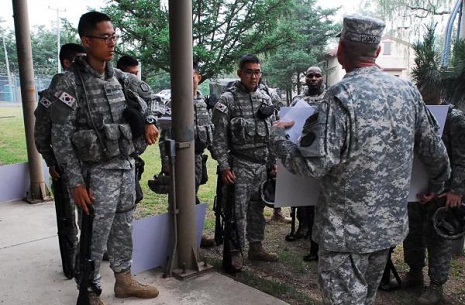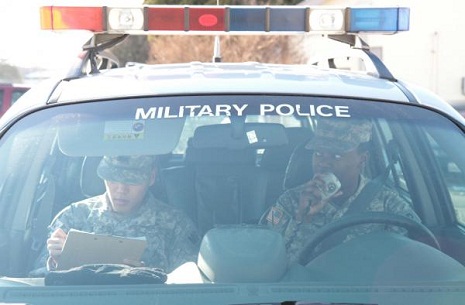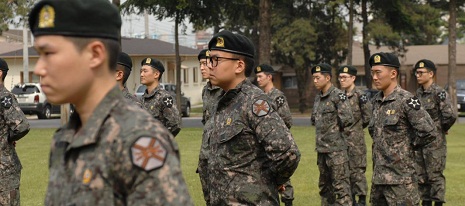The reformed division includes a combined headquarters unit, a U.S. infantry brigade and a South Korean mechanized infantry brigade. The division`s commander is American, and his deputy is South Korean.
But it`s not a huge step. For more than a half century, South Korean troops have volunteered to work directly with American troops through the Korean Augmentation to the United States Army program, or KATUSA.
It`s a unique program. We`re tempted to make comparisons to the British Gurkhas … but it`s actually a lot different. It`s certainly no French Foreign Legion. Officially, the troops are still part of the South Korean army.
But every year, the U.S. Eighth Army — the ground branch`s main headquarters on the peninsula — figures out how many Korean personnel they can accommodate, and where they need them to go.
Seoul`s troops work as intelligence analysts, chemical warfare specialists, and computer technicians, according to an official U.S. Army organizational document we obtained through the Freedom of Information Act.
These positions give these KATUSAs an opportunity to get specialized training and make good use of their own language skills.
"KATUSAs acquire a wide variety of military specialties and leadership skills that have direct benefits for their future careers, as well as Korean society writ large," Eighth Army public affairs officer Col. Shawn Stroud told War Is Boring.
The South Korean soldiers take up posts as healthcare providers, legal aids, administrative personnel, multimedia illustrators, truck drivers, and even assistant chaplains. South Korean troops even work in American command posts and in the Eighth Army band.

The KATUSA program arose from a shared history of war with North Korea. Both American and South Korean troops fought together, so it made sense to make it official.
Gen. Douglas MacArthur and South Korean Pres. Syngman Rhee crafted the arrangement in 1950, and both viewed these "augmentees" as critical to their shared war efforts.
In June 1950, a North Korean blitzkrieg had pushed Washington and Seoul`s ill-prepared troops into a tiny pocket around the port city of Busan at the southeastern tip of the peninsula.
With Pyongyang`s forces closing in, MacArthur was desperate for more manpower. Rhee wanted to find ways to improve his fledgling army.
"An inordinately large percentage of men, particularly in some units, stated at KATUSAs were no good, that they would sleep on guard, ‘bug out,` refuse to work or pretend not to know what was expected of them," an Army team sent to evaluate the service`s performance reported.
Despite orders from Pres. Harry Truman to integrate, Eighth Army had arrived in Korea with official racial boundaries still firmly in place.
"This mistrust may stem from fact or it may result from pre-existing attitudes," the team explained. "Many people made the statement that a KATUSA or Puerto Rican or Negro is either an excellent fighter, or he is no good at all."
"If such ‘extremes` exist it seems highly likely that they are not inherited."
In spite of these barriers, more than 6,000 KATUSAs had given their lives by the end of the war. After the Korean Armistice Agreement stopped the shooting, the Pentagon kept the program going as an established method of training South Korean troops.
Nearly 10 years after the armistice, Washington and Seoul agreed to use the arrangement to bulk up Army units throughout the country. In 1968, there were still more than 10,000 KATUSAs aiding the ground combat branch in Korea, according to one Pentagon memo.
The relative skill level between South Korean troops and their American comrades — and perhaps continuing mistrust — was still an issue. "KATUSA personnel cannot be used in intelligence units to replace U.S. personnel," the Pentagon memo declared.
And for decades, the U.S. essentially had veto power over the South Korean military. The American officer in charge of the Eighth Army — who had a shared headquarters with South Korean troops called the Combined Forces Command — was the de facto highest ranking military official in the country.
In 1994, the two countries finally agreed to allow South Korea — an established sovereign state and growing regional economic powerhouse — to oversee its own military affairs … during peacetime.
Today, if another war broke out on the peninsula, the Pentagon would still direct South Korean troops at the highest levels.

The face of both the Army in South Korea and the KATUSAs also changed with the times. After the Cold War ended, the Pentagon started pulling thousands of American troops from the country.
In the process, the Army disbanded whole units or sent them back to U.S., limiting the number of places American commanders could send the Korean augmentees.
This arrangement only exists between the two countries` ground combat branches. Other services, such as the U.S. Air Force and Marines, do not have any similar programs with South Korean forces.
And buoyed by years of relative peace, Seoul shortened compulsory military service, shrinking the pool of potential volunteers. Many KATUSAs leave the South Korean military entirely after their required service period ends.
"Unlike what some people think of us, most KATUSA soldiers actually try to get something out of their service," Sgt. Won Jung Ho, a South Korean soldier assigned to the 2nd Infantry Division, explained to American military reporters three years ago.
South Korea still pays these volunteers as though they were in regular units, saving the Pentagon money in an era of budget cuts. However, the Eighth Army is responsible for feeding and housing the South Korean troops.
Per the agreement, KATUSAs are not subject to the Pentagon`s Uniform Code of Military Justice. Army personnel have to report South Korean troops to their commanders for any disciplinary action, putting them on equal footing with their American partners.
"It is important to remember that our KATUSA Soldiers are [Republic of Korea] army soldiers assigned to U.S. units and they deserve our trust and respect," Army Maj. Gen. Thomas Vandal, head of the 2nd Infantry Division, told his troops in a memo two years ago. "Under no circumstances will these personnel be subjected to any form of verbal abuse or threatened."
With the Korean war more than six decades in the past, the program also gives younger Koreans a direct insight into how the U.S. Army functions in their country.
Since high profile violent crimes — including murder, rape and assaults — and deadly accidents have often painted American soldiers in negative lights, the KATUSAs are an important public relations tool.
With these benefits, the KATUSA program looks unlikely to change much in the near future. Washington and Seoul have repeatedly delayed plans to end formal wartime ties. On top of that, they`re setting up a binational infantry division.
This is all happening as North Korean dictator Kim Jong Un has been keen to assert his authority through threats and other fiery rhetoric.
A series of North Korean provocations — most notably the sinking of the South Korean Navy corvette Cheonan and the shelling of Yeonpyeong island, both in 2010 — ensures that neither country is in any particular rush to scale back their military relationship.
Quite the contrary.
More about:
















































